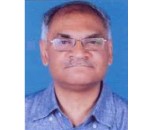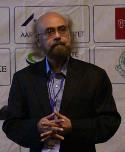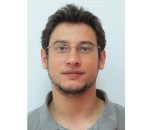Day 3 :
Keynote Forum
Vladimir Zaichick
Medical Radiological Research Centre, Russia
Keynote: Role and Place of Mass Spectrometry in Medical Elementology - a New Scientific Discipline
Time : 9:00- 9:30

Biography:
Vladimir Zaichick is a Nuclear Physicist, Biologist and Researcher. He obtained his MS in 1966 from the Moscow Institute of Engineering Physics, his PhD (nuclear physics) in 1972 from the Institute of Biophysics, Moscow, and his DSc (radiobiology) in 2011 from Medical Radiological Research Center, Obninsk, Russia. He is a full professor of radiobiology, a fellow of the British Royal Society of Chemistry (FRSC) and a Chartered Chemist (CChem) since 1996. He has made 141 presentations at seminars and conferences, published more 300 papers in reputed journals and is serving as an editorial board member of four scientific journals.
Abstract:
Since the times of the alchemists, chemical elements have been investigated in human organs, tissues and fluids. During the last decades the number of publications devoted to them increased considerably. Today, the number of published articles may be estimated at about twenty thousands, and the amount of monographs about hundred. This vast amount of data, dealing with the importance of elements acquired in different fields of scientific research and practical life, puts forward the need for a synthetic approach in element research. At the end of the 20th century, a new scientific discipline appeared, focused on the role of chemical elements in human body under physiological and pathological conditions. This new field of interdisciplinary study has been named: “Medical Elementology” (from lat. “medicina” and “elementum”). A lot of medical doctors, toxicologist, ecologist, chemists and physicist who were involved in the study of chemical elements in medicine and biology had thus the feeling that they were working in new self-sufficient scientific sphere. As a rule, all scientific disciplines are characterized, first of all: 1) by the subject of study; 2) by accepted postulates; 3) by research methods; 4) by methods of quality control; 5) by terms and definitions. Instrumental analytical methods such as non-destructive NAA and EDXRF as well as destructive AAS, ICP-AES and ICP-MS are the main research instruments in Medical Elementology. Role and place of ICP-MS will be discussed using our results obtained in the age-dependence studies of 67 chemical element contents in human bone, hair and prostate gland.
- Applications of Mass Spectrometry | Recent Advances and Development in Mass Spectrometry | Hyphenated Techniques

Chair
Yi-Ting Chen
Chang Gung University, Taiwan

Co-Chair
Sanjeeva Srivastava
Indian Institute of Technology Bombay, India
Session Introduction
Alberto Fontana
Janssen Research & Development, Spain
Title: Automated Open-Access Liquid Chromatography High Resolution Mass Spectrometry to Support Medicinal Chemistry Projects

Biography:
Alberto Fontana completed his Master of Science in Chemistry from University Autónoma of Madrid. He joined Janssen Research & Development (Spain) in 1998. Since 2001, he works as Scientist in the Analytical Sciences Team. He is focused on analytical LCMS, GCMS and on preparative LC, developing new methodology for Medicinal Chemistry groups, mainly within Neuroscience area. He is currently doing his PhD studies at University of Alcalá de Henares, Madrid. He is the main author of 1 publication and co-author of another 5 papers. He has presented several posters with his research work on LCMS at different international congresses.
Abstract:
The need of a continuous productivity increase in the pharmaceutical industry motivated the development of new Open-Access tools on many analytical techniques [1-5]. On LC, these platforms have been commonly used with low-resolution MS detectors while they have been reported with very limited automation on high-resolution MS spectrometers [6]. Typically, samples with concentration ranges around 0.1 mg/mL are prepared by medicinal chemists for reaction monitoring and for UV purity assessment. Together with the evolution of the instrumentation, new software packages to automatically process HRMS data have appeared [7, 8]. These systems are typically run by specialists and developed for biological samples with compounds in concentrations of µg/mL range. In this work, the development of a Fully Automated Open-Access methodology on a UHPLC-DAD/ESI-QTOF system is reported, being applied to medicinal chemistry discovery projects from Janssen R&D. With the first MS conditions applied, accuracies < ±1 mDa were not achieved in 20-30% of the cases in ESI+ due to oversaturation. After optimization of MS conditions, a new ESI+ method was implemented. This method has been used by chemists for more than 2.000 compounds from structurally diverse chemical series with a success >98% in exact mass determinations. For the other 2 % of the samples, specific conditions are used. Upon training, chemists log-in samples and interpret the results by themselves in 90-95 % of the cases. To our knowledge, this the first time that this Full Automation has been achieved for an Open-Access LC-DAD-HRMS platform developed for end-users in a pharmaceutical environment.
Ivo Leito
University of Tartu, Estonia
Title: Validation of liquid chromatography–mass spectrometry methods

Biography:
Ivo Leito works as professor of analytical chemistry at Institute of Chemistry, University of Tartu. His main research directions are on the borderline of analytical chemistry with other disciplines: chemistry of superacids and superbases; metrology and quality assurance in chemistry (MiC); liquid chromatography and mass spectrometry; sensors and their metrological characterization; applications of instrumental
Abstract:
The presentation gives an overview of the recently published two-part tutorial review on validation of liquid chromatography–mass spectrometry methods.The tutorial review presents the state of the art of method validation in liquid chromatography mass spectrometry (LC–MS), especially with electrospray ionization (LC-ESI-MS), and discuss specific issues that arise with MS (and MS-MS) detection (i.e. LC-MS-MS) in LC (as opposed to the “conventional” detectors). The review addresses and compares all the major validation guidelines published by international organizations: ICH, IUPAC, AOAC, FDA, EMA (EMEA), Eurachem, SANCO, NordVal and the European Commission Decision 2002/657/EC. With every performance characteristic the tutorial review briefly compares the recommendations of the guidelines, to a large extent on the basis of the experience of the authors. All important method performance characteristics are discussed. With each of them its essence and terminology are addressed, the current status of how to treat it is reviewed and recommendations are given, how to determine it, specifically in the case of LC–MS methods. A possible step by step validation plan specifically suitable Tutorial review on validation of liquid chromatography–mass spectrometry methods: Part I. A. Kruve, R. Rebane, K. Kipper, M.-L. Oldekop, H. Evard, K. Herodes, P. Ravio, I. Leito. Anal. Chim. Acta 2015, 870, 29-44. Tutorial review on validation of liquid chromatography–mass spectrometry methods: Part II. A. Kruve, R. Rebane, K. Kipper, M.-L. Oldekop, H. Evard, K. Herodes, P. Ravio, I. Leito. Anal. Chim. Acta 2015, 870, 8-28.

Biography:
Dr. Sanjeeva Srivastava is Associate Professor and group leader of proteomics laboratory at Indian Institute of Technology, Bombay. He obtained his Ph.D from the University of Alberta and post-doc from the Harvard Medical School in the area of proteomics, stress physiology and has specialized expertise in applications of data enabled sciences in global health, developing country and resource limited settings. Current research in this group centers on biomarker and drug target discovery and deciphering the protein interaction networks in complex human diseases (gliomas) and infectious diseases (malaria) using high throughput proteomics, protein microarrays and mass spectrometry. Dr. Srivastava is an active contributor to global proteomics science and innovation. He serves on the Council of Human Proteome Organization (HUPO) and Executive Committee of Proteomics Society, India (PSI). He had organized two successful conferences – PSI-2014 and Targeted Proteomics International Symposium in 2015. He has published three special issues as editor, “Proteomics in India” for Journal of Proteomics; “Proteomics Research in India” for Nature India and “Protein Arrays” for Proteomics. Having extensive teaching experience at IITB and experience of conducting proteomics courses at CSHL provided him with the background to increase proteomics education for the global community. One of his special contributions has been the development of e-learning resources (MOOC, Virtual Proteomics Laboratory). He continues to develop proteomics & omics science and innovation together with and for the next generation of keen students, researchers and the research and education commons in Asia and global OMICS community.
Abstract:
Glioma brain tumors arise from glial cells. Glioblastoma multiforme (GBM) is the most common and most malignant of the glial tumors. We have performed a comprehensive iTRAQ-based quantitative tissue proteomic analysis of gliomas and compared it with different controls, including other cancer samples as disease control to identify differentially expressed proteins in different groups of brain tumors. The iTRAQ-labeled peptides were fractionated using off-gel fractionation followed by LC-MS/MS analysis. Various metabolic pathways including fructose & mannose metabolism, spliceosome and aminoacid metabolism were found to be altered in GBM, medulloblastoma and meningiomas respectively. Proteins like CRYAB, GFAP, BASP1 and SNCA were found to be significantly altered in gliomas, where as VIM, RABP1, ANXA2 and SBP1 showed differential expression in meningiomas. Protein biomarkers identified from discovery-phase were further validated using MRM-based quantitative approach. Targeted proteomics data was analyzed using Skyline and for each protein a minimum of 3 peptides with at least 3 corresponding transitions were used for quantification. The in-solution digested peptides from the tissue lysates were run on triple quadrupole mass spectrometry. This comprehensive mass spectrometry based quantitative and targeted proteomic profiling of brain tumors identified few potential markers and provided insights into tumor pathophsyiology.
Yi-Ting Chen
Chang Gung University, Taiwan
Title: Clinical proteomics for biomarker discovery and verification of bladder cancer

Biography:
Dr. Yi-Ting Chen received her Ph.D. degree in Department of Chemistry from the National Tsing Hua University, Taiwan. From September 2007, she worked at Molecular Medicine Research Center of Chang Gung University (CGU) with focusing on urinary protein biomarker discovery. Being an assistant professor in Department of Biomedical Sciences of CGU since 2013, Dr. Chen’s research interests focus on proteomics, metabolomics and systems biology of urological diseases and advanced method development for detection of disease-associated biomolecules, primarily based on mass spectrometry. Dr. Chen participates in several integrated research programs and serves as an investigator for translational application of omics studies.
Abstract:
Bladder cancer is potentially lethal and is a costliest urological malignancy to manage. Base on the morbidity and mortality, diagnosis and treatment of the cancer are important issues for the better clinical practice. To discover potential biomarkers of bladder cancer, we employed a strategy combining isotopic labeling and LC-MS/MS analysis to profile proteomic changes in secretome, clinical urine, urine microparticles, and fresh-frozen bladder tumor specimens. Seven differentially-expressed proteins have been selected as potential biomarker candidates for verification by immuno-assays or multiple-reaction-monitoring MS in more clinical specimens. Overall, the urinary concentrations of the classical plasma proteins or acute phase proteins show the best AUC values for discrimination between age-matched control and bladder cancer patients. Proteomic analysis of urinary microparticles reveals strong association of TACSTD2 with bladder cancer. TAGLN2 shows the most significant overexpression in bladder cancer tissues and might be a useful molecular tumor marker for evaluating bladder cancer lymph node metastasis. Urinary TAGLN2 also represents a potential biomarker for non-invasive screening of bladder cancer. Our findings highlight the value of integration of multiple clinical proteomes in providing valuable information for protein origin, specificity and application for future validation studies of potential biomarkers in bladder carcinoma.
Dinkar Sahal
International Centre for Genetic Engineering and Biotechnology (ICGEB), India
Title: Explorations into isomeric peptides of opposite directionalities by tandem mass spectrometry

Biography:
Dinkar Sahal’s laboratory epitomizes a vibrant atmosphere for both design and discovery of novel antibiotic peptides and antimalarial drugs. The foundations for understanding the mechanisms of action and discovery of the origins of potency, synergy among antibiotics and broad spectrum of action of antibiotic peptides has been laid in his laboratory. Likewise discovery of novel drugs against drug resistant malaria is a major passion of his laboratory. He has published more than 75 papers in reputed journals and has been serving as a Reviewer and an Editorial Board Member of different journals.
Abstract:
Only one and not the other, ‘retro’ direction that every protein sequence takes is a curious evolutionary question for both biology and mass spectrometric analysis of proteomes. Further impetus on retro sequences came from bioinformatic analysis of proteins revealing the presence of unique inverted peptide sequence pairs of lengths 5-12 and 18 amino acid residues accommodated in natural proteins [Sridhar&Guruprasad 2014]. Consequently we decided to address this question by MS/MS using ribonuclease A derived S peptide: K1ETAAAKFERQHMDSS16 vs Retro S (RS) peptide: S1SDMHQREFKAAATEK16 as models. Collision induced dissociation was carried out within linear trap quadrupole at different collision energies (CEs), on [M+2H]2+ precursor ions (m/z 918.44) produced by electrospray ionization of the two peptides and product ion analysis was by orbitrap. Degree of fragmentation of each of the fifteen peptide bonds of peptide molecular ions was determined by estimating relative abundance of b- and y- ions, with reference to precursor ions, at every CE. The greater fragility of RS peptide than S peptide was evident from determinations of minimum CE, at which, the precursor ion population is 50% (CE50) or 0% of the initial populations (CE*). The values of CE50 and (CE*) were 23.6(30) and 22.6(28) for S and RS peptides, respectively. In view of the conformational propensity of S peptide to be more structured than RS peptide [Pal-Bhowmick et al. 2007), our data suggest that solution structures of these peptides may be preserved also in gas phase. This augurs well for application of high-resolution CID to probe conformational properties of peptides in gas phase.
- Applications of Mass Spectrometry | Mass Spectrometry Imaging | Mass Spectrometry in Toxicology

Chair
Nives Galić
University of Zagreb, Croatia

Co-Chair
Pedro José Sanches Filho
Instituto Federal Sul-rio-grandense, Brazil
Session Introduction
Nikolay Solovyev
St. Petersburg State University, Russia
Title: Analytical aspects and biomedical applications of selenium speciation

Biography:
Nikolay Solovyev was born in 1986 and has completed his PhD at the age of 25 years from St. Petersburg State University. He is an analytical chemist, and a lecturer in analytical chemistry at the Institute of Chemistry, St. Petersburg State University. His primary field of expertise is clinical elemental analysis, speciation analysis and trace element metabolism.
Abstract:
Analytical challenges of selenium (Se) species determination, using hyphenated techniques, are discussed. Se is ‘complicated’ element for the inductively coupled plasma (ICP) based techniques, owing to relatively low sensitivity and abundant interferences. Since emission lines of Se are insensitive, nearly exclusive mass spectrometry (MS) detection is used for Se speciation in biological samples. Nevertheless, selenium detection by ICP-MS is considerably less sensitive compared to most elements. This is due to rather high ionisation potential of Se, its natural isotope distribution and spectral interferences, originating from argon of the ICP as well as sample bulk elements. Noteworthy, all Se isotopes are interfered to certain extent. A primary isotope 80Se (abundance 49.61%) is totally interfered by argon dimer, whereas the less interfered 77Se has abundance of 7.63% only. Severe interferences for Se require for the implementation of sector-field MS or using of collision or dynamic reaction cell technologies for Se quantification and speciation. The best performance, in respect of limits of detection, is obtained for collision or dynamic reaction cells with oxygen/hydrogen or methane as working gases. Additional analytical complications of Se speciation are related to separation and identification techniques, since biologically relevant Se-species diverse highly in their chemical nature: inorganic (selenite and selenate), organic, including seleno amino acids (selenocystein, selenomethionine), low molecular weight species, specific selenoproteins (selenoprotein P, glutathione peroxidase, thioredoxin reductase etc.) and non-specific selenised proteins (e.g. selenised human serum albumin). The main biomedical applications of Se speciation are epidemiologic studies, selenium metabolomics and risk assessments studies.
Nives Galić
University of Zagreb, Croatia
Title: Structural investigation of organic compounds and their complexes by ESI MS/MS

Biography:
Nives Galić was born in Zagreb, Croatia where she graduated from the Faculty of Science, University of Zagreb, with a B.Sc. degree in Chemistry (1992); received a Mr. Sc. degree (1995) and a Ph.D. degree in Analytical Chemistry (1999). In 2011 she was elected to the position of Associate Professor and become the Head of the Division of Analytical Chemistry. She has published over 30 papers which have been cited over 700 times. She was supervisor of 25 diploma thesis and two PhD theses (+ 6 in progress). She is a leader of the project funded by Croatian Science Foundation (IP-2014-09-4841).
Abstract:
The application of electrospray tandem mass spectrometry (ESI MS/MS) in organic analysis, as well as in pharmaceutical industry, will be presented and discussed on several examples as follows:
1. Structural isomers of aromatic hydrazones derived from nicotinic acid hydrazide were identified due to comprehensive study of their fragmentation pathways. Isomers derived from 3- and 4-hydroxy salicylaldehyde, as well as those derived from 3- and 5-chloro salicylaldehyde were distinguished due to "ortho effect". The MS/MS spectra and fragmentation pathways of compounds derived from 3- and 4-methoxy salicylaldehyde differ due to enolimino-ketoamino tautomeric interconversion of one isomer.
2. Peptidocalixarenes bearing tryptophan, phenylglycine and leucine at the lower rim and their complexes with alkali-metal (Li+, Na+, K+, Rb+, Cs+) and selected lanthanide cations (La3+, Ce3+, Eu3+, Yb3+) were analyzed by ESI MS/MS. The results of MS analysis were in accordance with those obtained by other techniques (spectrophotometric, potentiometric, and conductometric titrations). The MS/MS experiments could be used as fast and sensitive method for prediction of relative stabilities of calixarene complexes with metal ions.
3. Bivalirudin, a synthetic oligopeptide, is used as anticoagulant for patients with acute coronary syndromes or patients undergoing percutaneous coronary intervention. Forced degradation studies were performed using acid, base, H2O2, heat and light exposure as recommended by the International Conference on Harmonization (ICH). An UPLC method with UV detection for determination of bivalirudin in the presence of its degradation products has been developed. However, for the identification of degradation products the 2D LC MS/MS system had to be used.
Pedro José Sanches Filho
Instituto Federal de Educação Ciência e Tecnologia Sul-rio-grandense, Brazil
Title: GC/MS application in the determination of lipids in archaeological artifacts samples

Biography:
Dr Pedro José Sanches Filho graduated in Full Degree in Chemistry and graduate in Pharmacy (1988), master's degree in Chemistry from the Federal University of Rio Grande do Sul (1997) and a PhD in Chemistry from the Federal University of Rio Grande do Sul (2002) and post doctorate from the Nova University of Lisbon (2007). He is currently Professor and Researcher at the Federal Institute of Education, Science and Tecnolgia sul-rio-grandense, leader of the Research Group on Environmental Contaminants.
Abstract:
The connection of chemistry as a science with conservation-restoration and historical research of cultural property is of great importance, that because these materials (artifacts, buildings, etc.) are able to store chemicals that allow information both cultural aspects (actions anthropic) as non-cultural (vegetation, and others). The necessity of methods to extract, identify and quantify chemical compounds stored in archaeologies samples such as ceramics, accurately and precisely, makes the gas chromatography coupled to mass spectrometry (GC/MS) to appear as an important analytical tool. This work aims at the optimization methodologies by GC/MS for characterizing lipids found in archaeological artifacts (ceramic fragments) obtained in Cerritos located in the Pampa biome, in the southern portion of the Patos`s lagoon, southern Rio Grande do Sul-Brazil. The methodology is based in a solvent extraction of lipids under ultrasound, clean up by micro silica column and derivatization with MSTFA (N-methyl-N-trimethylsilyltrifluoroacetamide) and analysis by GC/MS. A better characterization, with clarification of several isomeric structures, was obtained in 4.0 g of sample and 30.0mL eluent (CHCl3:CH3OH 2:1 v/v)during the passage in the micro-column with silica. The study allowed us to optimize the methodology for extraction, clean up, pre concentration, identification and quantification of lipid compounds (fatty alcohols, fatty acids, triglycerides) in samples of ceramic artifacts, and identify contamination in the samples in the stages of collection and storage. The results obtained from this method will enable a more accurate and precise correlation between chemical data and the behavior of indigenous pre colonization cultures.
Radostina K. Manova
NVWA, Product Safety Authority, The Netherlands
Title: An application of HRMS QTOF in the routine analysis of veterinary drug residues

Biography:
Radostina K. Manova obtained her PhD from University of Wageningen in The Netherlands. During her PhD, she developed a new analytical approach for analysis and structural elucidation of covalent bound monolayers with the use of ambient ionization and high-resolution mass spectrometry. Currently, she is working as a research scientist at Netherlands Food and Consumer Product Safety Authority. Her research topics are development of analytical methods for determination of veterinary residues, and application of HRMS for broad screening and for confirmation of veterinary drugs and growth promoters.
Abstract:
The use of veterinary drugs in food-producing animals may pose a risk to public health. In order to protect the public and animal health, the EU legislation requires monitoring programs assuring that veterinary residues do not exceed maximum residue limits. For the implementation of such programs, the routine laboratories use targeted analysis for multi-residue determination with triple-quadrupole mass spectrometric detection (e.g. LC-MS/MS). Recently, the use of high-resolution mass (HRMS) analyzers has gained popularity for the screening of unlimited number of analytes in complex matrices. As a result, the HRMS analyzers are playing already a central role in routine pesticide residue analysis. However, the potential of HRMS methods in the analysis of veterinary drugs is not yet fully explored to the level of routine use. This presentation will discuss development and validation of a liquid chromatography–high resolution mass spectrometry (LC–HRMS) method for screening, identification and quantification of beta-agonists in biological matrices. The evaluation of data acquisition approach on hybrid quadropule-time-of-flight (QTOF) mass analyzer will be discussed: full-scan MS and a combination of full-scan and broadband CID experiments. The development of exact mass product ion spectra database and the selection of quantifier/qualifier ions for reliable identification will be described. The combination of highly selective HRMS method with a generic sample preparation will be evaluated for the targeted and non-targeted screening workflow. Finally, regulatory aspects concerning validation of HRMS methods will be also mentioned.
Gianluca Trifirò
Experimental Zooprophylactic Institute of Puglia and Basilicata Regions, Italy
Title: Novel approach for the determination by HPLC-MS/MS of microcystins LR, LY, LA, YR, RR, LF, LW, and nodularin in lake water and crops

Biography:
Gianluca Trifirò has completed his Master’s Degree in Analytical Chemistry from University ‘’Sapienza’’ of Rome (Italy). He is a researcher at the laboratory of mycotoxins and immunoassays techniques of the Experimental Zooprophylactic Institute of Puglia and Basilicata Regions (Italy). He has published several papers in reputed journals.
Abstract:
The occurrence of harmful cyanobacterial blooms in surface waters is often accompanied by the production of a variety of cyanotoxins, and these toxins are designed to target in humans specific organs on which they act. When introduced into the soil ecosystem by spray irrigation of crops, they may affect the same molecular pathways in plants having identical or similar target organs, tissues, cells, or biomolecules. There are also several indications that terrestrial plants, including crops, can bioaccumulate cyanotoxins and present, therefore, potential health hazards for humans. During this project, for monitoring purposes, water samples were collected from lake Occhito, in which there was an algal bloom (Planktothrix rubescens) in 2009, and from three tanks which acted as hydraulic junctions. In addition, crop samples irrigated with water from the three tanks mentioned above were also picked. Finally, the characterization of principal cyanobacteria was performed, to determine the presence of cyanotoxins such as microcystins and validate a HPLC-ESI-MS/MS method for the determination of microcystins in water and vegetable samples.
- Applications of Mass Spectrometry | New Approaches in Mass Spectrometry

Chair
Lingzhi Gong
Queen Mary University of London, UK

Co-Chair
R K Vatsa
Bhabha Atomic Research Centre, India
Session Introduction
Codjo Hountondji
University Pierre et Marie Curie (Paris 6), France
Title: Affinity labeling studies and mass spectrometric analyses on human 80S or E. coli 70S ribosomes reveal how the ribosomes translate cancer

Biography:
Codjo Hountondji has completed his PhD at the age of 30 years from University of Orsay (Paris 11, France). He is professor of Biochemistry and Molecular Biology at the University Pierre et Marie Curie (Paris 6, France) and director of a research team focusing on “the mechanism of peptide bond formation at the peptidyl transferase center, the active site of the ribosome” and on “the ribosome as a target for anti-cancer drugs”. He has published more than 40 papers in reputed journals.
Abstract:
Increasing evidence points to a connection between protein synthesis and cancer cell growth. For example, increasing the rate of protein synthesis is favorable to the increase in size of the cancer cells and hence to their subsequent division. Since the ribosome, with its functional sites A, P and E, is responsible for protein synthesis in all kingdoms of life, it may be considered as a target of new cancer therapeutics. Here, by combining affinity labeling studies and mass spectrometric analyses on human 80S or E. coli 70S ribosomes, we have demonstrated the following: (i) ribosomal proteins rP-eL42 of human 80S ribosomes and rP-bL12 of E. coli 70S ribosomes can be affinity labeled in situ with the CCA-end of tRNAox, a tRNA analogue bound to the P-site; (ii) the residue of eL42 or bL12 cross-linked with tRNAox is Lys-53 and Lys-65, respectively; (iii) the CCA-end of P-tRNA contacts both eL42 and the A-site bound translation termination factor eRF1 at the peptidyl transferase center, the active site of the human 80S ribosome; (iv) the residue of eRF1 cross-linked with tRNAox is Lys-197. Since previous studies had demonstrated that rP-eL42 is overexpressed in human hepatocellular carcinoma as well as in several human tumor cell-lines, while an increased exposure of intestine to bacterial bL12 was previously observed in colorectal cancer patients, our results suggest that the functional role of these rPs might be related to tumor cell proliferation. In addition, our results provide new insights into the mechanism of the peptidyl transfer reaction.
R.K. Vatsa
Bhabha Atomic Research Centre, India
Title: Photoionisation of nanoclusters : Collisional heating of confined electrons

Biography:
Dr. R.K. Vatsa did his M.Sc. (Physical Chemistry) from Delhi University and obtained his Ph.D. from University of Mumbai, India followed by postdoctoral research at Heidelberg University, Germany. He is currently Heading Structural Chemistry Section in Chemistry Division of BARC. He has published 150 research papers in internationally reputed journals. He is President of Indian Society for Mass Spectrometry (ISMAS) and an elected fellow of National Academy of Sciences (NASI), India.
Abstract:
A nanocluster is a collection of atoms/molecules held together by weak van der Waals forces. These tiny balls of nanometer dimension are of great interest in physics and chemistry since the matter in nano form behaves differently than the bulk form. How do these nanoclusters behave as far as their interaction with a pulse of light is concerned, will be the subject matter of this presentation. It will be shown that nanoclusters, surprisingly, absorb large number of photons (hundreds to thousands per cluster) from the non-resonant optical field. Experimental results show that photoionisation of clusters using giga watt intensity laser pulses (l = 532 or 1064 nm) produces multiply charged atomic ions (as high as +8 state). The enormous amount of energy absorbed from laser pulse causes multiple ionisation of the constituent atoms/molecules. The presence of highly charged atomic ions being in close proximity leads to strong Coulombic repulsive forces and eventually the entire cluster undergoes violent disintegration known as Coulomb explosion. The end products of Coulomb explosion are multiply charged ions and energetic electrons as detected experimentally. The charge state of atomic ions and kinetic energy of electrons is higher in case of photoionisation by infrared photons as compared to UV-Vis photons. Further, a threshold cluster size is critical below which multiply charged atomic ions are not observed. The results have been explained based on the formation of nano-plasma by the leading edge of laser pulse (FWHM= 10 ns) which then interacts with the remaining portion of the pulse. The optical energy is coupled into the cluster by collisional heating of confined electrons inside the cluster. The large experimental data suggest that after initial multiphoton ionisation of atoms/molecules, secondary ionisation of cluster constituents is dominated by the energetic electron impact ionisation leading to multiple ionisation and concomitant effects.
Lingzhi Gong
Queen Mary University of London, UK
Title: Analysis of Oligonucleotides by Ion-pair Hydrophilic Interaction Liquid Chromatography/Electrospray Ionization Mass Spectrometry (IP-HILIC/ESIMS)

Biography:
Lingzhi’s general research interests include mass spectrometry based analysis of small molecules and biomolecular molecules (nucleic acids, peptides, proteins) through hyphenated to a chromatographic method (mainly liquid chromatography), and research into chromatographic retention mechanisms. His current work focuses on characterizing single- and double-stranded DNA/RNA, and protein/peptide - DNA crosslinking complex using hyphenated liquid chromatography and electrospray mass spectrometry (LC-ESIMS). Lingzhi currently runs Core Mass Spectrometry Research Facility at Queen Mary University of London.
Abstract:
Synthetic oligonucleotides are widely used in the polymerase chain reaction (PCR) as DNA primers or in molecular biology as probes to screen for diseases, viral infections, and to identify genes. Sensitive and selective methods have always been demanded for the characterization of oligonucleotides, especially, when the oligonucleotides are applied as therapeutics. Ion-pair reversed-phase (IP-RP) liquid chromatography has been commonly used for the analysis of oligonucleotides, but ion suppression is a major problem when coupling with electrospray mass spectrometry (ESI-MS). Although the introduction of hexafluoroisopropanol (HFIP) in the mobile phase has improved MS detection sensitivity of oligonucleotides, this mobile phase system results in a severe problem with adducts formation particularly if large oligonucleotides are analysed. An alternative chromatographic approach, hydrophilic interaction liquid chromatography (HILIC), was recently employed for the analysis of oligonucleotides. It provided enhanced MS sensitivity with fewer adducts but lacked chromatographic resolution for some oligonucleotides. Here we improve chromatographic resolution whilst maintaining MS sensitivity by adding an ion-pairing reagent, triethylammonium acetate (TEAA), into the HILIC mobile phase. The IP-HILIC approach produces lower retention capacity and has the added benefit of providing simpler MS spectra, with fewer charge states, when comparing with HILIC. We suggest a mechanism for ion-molecule interactions in IP-HILIC.
Xuewu Zhang
South China University of Technology, China
Title: Proteomic analysis of anti-photoaging activity of the acetylated and amidated peptide GMCCSR

Biography:
Xuewu Zhang obtained his PhD from Zhongshan University in 1993. Subsequently, he worked as a postdoctor in Hong Kong University, University of British Columbia, University of Manitoba and University of California at Los Angeles. Then, he come back to Hong Kong University as a Research Assistant Professor in 2003. At last, he joined South China University of Technology as a professor in 2005. His research interests focus on Food Science, Omics technologies and nanotechnology. He has published more than 80 papers in reputed journals and served as editorial board members of several journals.
Abstract:
In previous study, a hexapeptide with sequence of GMCCSR was identified from trpsin-digested whole protein of Spirulina platensis, and further study demonstrated that this peptide possessed antioxidant and anti-aging activities in vitro. In this study, the acetylated and amidated modification were employed to improve skin permeability of the peptide. The in vivo experiments showed that the acetylated and amidated peptide GMCCSR exerted good anti-photoaging effects on skin of mice by increasing the collagen production and activities of antioxidant enzymes SOD, GSH-Px and CAT. Subsequently, proteomic analysis using iTRAQ-based mass spectrometry technology was used to explore potential mechanisms. The results indicated that the acetylated and amidated peptide differemtially influenced the expression of 60 proteins. Among them, 33 proteins were up-regulated and 27 proteins were down-regulated. Based on bioinformatics analysis, the metabolic pathways and network related to skin photoaging were identified.
Saima Zafar
University Medical Center Goettingen (UMG), Germany
Title: Proteomic Approaches to Identify the Mechanism of rapid progression of Alzheimer's Disease

Biography:
Abstract:
Wenjie Cao
SABIC Technology Center, Saudi Arabia
Title: From ESI to APCI, MMI and APPI, Complications of Adduct Ions on MRM at Different LC-MS/MS Ionization Techniques

Biography:
Wenjie Cao received Ph.D. from Professor John Calvin Giddings’ Group at the University of Utah, Salt Lake City, UT. Contributor to the book of the Encyclopedia of Chromatography and more than 20 publications and presentations in peer-reviewed scientific journals and international conferences. Had worked for Huntsman Polymers Corp, Sealed Air Corp, and DuPont, as a Research Investigator, for 14 years in USA before joined SABIC in 2012. Now the Technical Leader of the Chromatography and Wet Lab and a Staff Scientist of the Analytical Department of the SABIC Technology Center at Riyadh, have filed six patents and delivered talks and made seminar presentations in the ISPAC Symposium 2016 and in King Saud University etc. since joint SABIC Technology Center.
Abstract:
This presentation is going to extend the comparison of ESI and APCI to MMI and APPI per some of the audiences’ request during the Q&A section of my presentation during the 2015 International Summit on Current Trend of MS in New Orleans. For the triple quadrupole LC-MS/MS instrument, the primary purpose or the most significant feature is the highest sensitivity among almost all, if not all, of the LC-MS/MS instruments by doing the Multiple Reaction Monitoring (MRM) testing. Ionization efficiency, selectivity, adduct ion production are among the top parameters which affect the MRM testing and the sensitivity. From ESI to APCI to MMI and APPI, this presentation will show the species and amount of adduct ions produced at each mode are quite different. Some type of the adduct ions may complicate the MRM testing by decreasing the sensitivities while some other adduct ions may prevent any reliable MRM tests being performed. Some examples will be presented to show how the typical adduct ions are produced in each mode from ESI to APCI and APPI, and how the typical adduct ions may complicate the MRM testing. The overall pros and cons, and the best ionization mode for some type of the targeted chemicals will be summarized for the different ionization techniques.
Makhapa Makhafola
Research & Development Mintek, South Africa
Title: The assessment of the exposure levels to mycotoxins among dairy cattle in the two South African provinces using HPLC (ESI)-MS/MSn

Biography:
Dr Makhafola is currently the General Manager: Research & Development at Mintek. He worked as Lecturer in Analytical Chemistry at Technikon Northern Gauteng (now called Tshwane University of Technology) and University of Venda. In 2004 was appointed Director: Quality Assurance at Border Technikon (now called Walter Sisulu University). Dr Makhafola was the Director: Quality Assurance at the University of Venda until he joined University of Kwa-Zulu Natal as the Director Quality Promotion & Assurance in July 2010, part of his responsibility was to lead the World University Rankings project.
Abstract:
Mycotoxins can be formed on crops in the field, during harvest, or during storage, processing, or feeding. Many different mycotoxins exist and they affect dairy cattle in many ways, the most important is perhaps immunosuppression. Symptoms of mycotoxins may be nonspecific and wide ranging which may include: reduced production, reduced feed consumption, intermittent diarrhea (sometimes with bloody or dark manure), reduced feed intake, thriftiness, rough hair coat, reduced reproductive performance including irregular oestrus cycles, embryonic mortalities. While mycotoxins can cause acute toxicity, they are more likely to cause chronic problems of increased disease and decreased milk production. Contamination of milk by aflatoxin can cause huge economic losses. Management of crops and feeds is important to reduce mycotoxin contamination. Mintek, undertakes research and development which focuses on various nanostructured materials and nano-minerals and their application in health (including diagnostics and therapeutics) and water treatment. The organization also seeks to advance the field of food security and as a results we partner with the University of Johannesburg for the assessment exposure levels to mycotoxins among dairy cattle in the Mpumalanga and Kwa-Zulu Natal provinces using HPLC (ESI)-MS/MSn. The levels and nature of mycotoxins and some of their main metabolites in dairy feed, raw milk and urine samples collected from some dairy cattle farms are currently being assessed and will be discussed in detail. The research project aims to generate data to propose recommendation to the South African government on the threat of mycotoxins contamination to animal and human health.

Biography:
Abstract:
The gas-phase conformation of the complexes of leucine-enkephalin (YGGFL) with Li+, Na+, and K+ were investigated by gas phase hydrogen/deuterium exchange-mass spectrometry (HDX-MS) combined with theoretical calculations. Different HDX performance were observed of enkephalin complexed with proton and Li+, Na+, and K+ ions. It was observed that [YGGFL+H]+ reacts continuously while the quenched reaction was found in the complexes of YGGFL with metal ions. For example, at the same HDX conditions, hydrogen exchanged in [YGGFL+H]+ and [YGGFL+Na]+ is 8 and 4, respectively. It is indicated that the two ions are of different conformation through various HDX performance. To further clarify the experimental results, the conformations were calculated by using density functional theory. It shows that the terminal amino group is the most thermodynamically stable protonation site, while the sodium ion coordinated four carbonyl oxygen atoms forms the most favorable sodium adduct. It is found that the difference in HDX might be attributed to less acidic hydrogen atoms in [YGGFL+Na]+ according to the charge and proton affinity calculated. The different conformations of leucine-enkephalin with Li+, and K+ complexes were further investigated for comparison. The results of this work is significant in physiology.
Yu Wang
The University of Hong Kong, Hong Kong
Title: Adipose tissue and adipokines as promising therapeutic targets for obesity-associated cardiovascular and metabolic diseases

Biography:
Dr Yu Wang has completed PhD at 2003 from University of Auckland, New Zealand. She has published more than 150 papers with high citations (H-index 42) and is serving as an editorial board member of various international reputed journals.
Abstract:
Obesity is the major driving force for cardiovascular and metabolic diseases, the leading causes of mortality and morbidity in the aged population. Currently, 2.1 billion people – over 30% of the world’s population – are either obese or overweight. This lifestyle-related epidemic has become and will continue to be a major societal, medical and economic problem in established and emerging industrialized countries. Adipose tissue (fat) is the largest energy storage and endocrine organ in the body. Adipose tissue dysfunction is the major culprit for obesity-associated cardiovascular and metabolic syndrome and has emerged as a promising therapeutic target. Here, I will summarize our discoveries during the past 15 years of proteomics-based research on a number of adipokines, including adiponectin, lipocalin-2 and adipocyte fatty acid binding protein (AFABP). In particular, I will demonstrate how the proteomics-based bio-discoveries allow us to proceed with various therapeutic development based on the druggable domains/structures of these adipokines.
Nour Eddine ES-SAFI
Mohammed V University of Rabat, Morocco
Title: Mass spectrometry as a powerful spectroscopic tool for the structural identification of natural phenolic compounds and their reaction products

Biography:
Professor Nour-Eddine ES-SAFI completed his PhD in organic chemistry in 1997 from Mohammed V University of Rabat, Morocco and postdoctoral studies at the French National Institute for Agricultural Research. He leads the Team of Organic Chemistry and the Physico-Chemical Studies at the Ecole Normale Supérieure, Mohammed V University of Rabat, Morocco where he is currently working as deputy director and a full professor. His research focuses on natural products, especially polyphenols, their structural elucidation, their antioxidant activity and their role in food technology and human health. He has published many research papers and he is reviewer for various international scientific journals. He is Editorial Board Member of various scientific journals and is Editor in Chief of the Green and Sustainable Chemistry journal.
Abstract:
Polyphenols are natural products which are recognized as one of the largest and most widespread class of plant constituents occurring throughout the plant kingdom. They are responsible for major organoleptic characteristics of plant-derived foods and beverages, particularly color and taste properties. Polyphenols have aroused considerable interest because of their potential beneficial biochemical and antioxidant effects on human health. Polyphenols show a great diversity of structures, ranging from simple molecules to polymers. They are also highly unstable compounds and can rapidly be transformed into various adducts when the plant cells are damaged, thus adding to the complexity of dietary polyphenol composition. Due to their great variety, their structural complexity and their high reactivity, the analysis of phenolic compounds is very challenging. Among the methods used for their analysis, mass spectrometry remains one of the important tools for their structural exploration. Its high sensitivity and the possibility of coupling liquid chromatography with mass spectrometry detection make of it a technique of choice for the investigation of complex mixtures like raw natural extracts containing polyphenols. With the development of soft ionization techniques, mass spectrometry has become a powerful analytical tool of polyphenols, polar, non-volatile, and thermally labile classes of compounds. In this presentation, application of mass spectrometry for the structural elucidation of natural polyphenols or their reaction products will be given. In particular analysis of flavonoids, oligomeric and polymeric procyanidins using electropsray (ESI), matrix-assisted laser desorption ionization (MALDI), and tandem (MS-MS) mass spectrometry will be also reported.
Miho TANAKA
University of Marine Science and Technology, Japan
Title: Laser ablation inductively coupled plasma mass spectrometry for quantitative imaging of elements in ferromanganese nodule

Biography:
Miho TANAKA completed PhD at the age of 28 years from The Tokyo University (Tokyo, Japan). She is specialized in Analytical Chemistry, Solution Chemistry and Mass spectrometry. Presently, she is actively involved in “chemical speciation” in solution, as well as other topics. She has published more than 70 papers in peer reviewed journals, and is the corresponding author in 90% of them.
Abstract:
Laser ablation inductively coupled plasma mass spectrometry (LA-ICP-MS) has been used for the quantitative elemental imaging of ferromanganese nodules to obtain the distributions of both major and trace elements, owing to its high sensitivity and wide dynamic range. In our study, data treatment system was developed for the quantitative imaging of elements in ferromanganese nodules. For obtaining a calibration line, a signal of Mg was monitored as an internal standard for correction. The validity of the values determined by LA-ICP-MS was confirmed by comparison with elemental contents obtained by ICP-MS. A two-dimensional plotting system for LA-ICP-MS was established for expressing elemental contents as colors along with spatial information. The simple method describes the ease with which the colors can be changed to define the content ranges of elements, and the elemental distributions show the layered structure, clearly depicting the contrast. Reproducibility of these analytical processes was also confirmed by analyzing two ferromanganese nodules. The method is expected to be a powerful tool for investigating paleo-environmental changes in the region surrounding a ferromanganese nodule and its formation processes.
Alessandra Maria Bossi
University of Verona, Italy
Title: Molecularly imprinted micro- and nano-materials for direct protein MALDI-TOF MS analysis

Biography:
AM. Bossi, PhD in Polymer Chemistry in 2002 (Cranfield University, UK), is Analytical Bio/chemist. She holds the Associate Professor Chair in Analytical Chemistry at the University of Verona (Italy), where she is leader of the research team on Biomimesis and Molecular Recognition. Main focus of her research is on the development of bioanalytical methods for protein and proteome analysis by: fundamental studies on hydrogels, preparation of biomimetic and responsive nanomaterials, molecular imprinting of polymers, integration of these materials to mass spectrometry and sensing. She is author of 78 papers in peer reviewed journals and 6 book chapters of bioanalytical methods.
Abstract:
Molecularly imprinted polymers (MIPs) are a class of tailor-made biomimetic materials, made by a template assisted synthesis and suitable for the recognition of target analytes, including peptides and proteins, with reported affinities and selectivity of the par of natural antibodies. With the aim to develop flexible analytical platforms performing high sensitivity and selectivity measurements, suitable for multi-biomarker determinations, the integration between the biomimetic MIPs and MALDI-TOF mass spectrometry (MS) was studied. Libraries of micro and nano-MIPs, including responsive MIP-materials, addressed at both peptide- and protein-biomarker were synthesized, characterized and coupled to MALDI-MS. The analytical performance and the extent of the applicability of the MIP/MALDI-MS was studied by challenging the system with selected biomarkers, present in serum at concentrations spanning from the nano- to the pico-molar, but bearing different characteristics in size, folding and complexity. Results indicate the coupling of micro and nano-MIP materials to MALDI-MS indeed generates rapid and highly sensitive detection methods. As MIPs are suitable “baits” for the general development of flexible platforms for the analysis of molecular biomarkers of clinical interest, MIP/MALDI-MS foreseen applications span from the global evaluation of the health status of patients, to functional proteomic research, letting envisage multiple domains of interest.
Purushottam Chakraborty
Saha Institute of Nuclear Physics, India
Title: Alkali containing molecular ions in SIMS: understanding of the emission phenomena

Biography:
Prof Purushottam Chakraborty is an ex- senior professor of Saha Institute of Nuclear Physics, Kolkata, India and an honorary professor of the University of Pretoria, South Africa. He is one of the leading SIMS experts of the world and has published more than 150 scientific papers and numerous reviews and book-chapters . He has edited a book ‘ion beam analysis of surfaces and interfaces of condensed matter systems (Nova Science, New York). He was awarded the ‘most eminent mass spectrometrist of India’ in 2003.
Abstract:
If alkali metals such as Li, Rb, K, Na, etc. (referred as A in general) are present in the neighbourhood of the probing element (M) on a sample surface, quasi-molecular ions can be formed by the attachment of these alkali ions [(MA)+ formation] in the secondary ion mass spectrometry (SIMS) process. Formation of these MA+ molecular ions has a strong correlation to the atomic polarizability of the element M. The emission process for the re-sputtered species M0 is decoupled from the MA+ ion formation process, in analogy with the ion formation in secondary neutral mass spectrometry (SNMS), resulting in a drastic decrease in the conventional ‘matrix effect’ in SIMS. Although the detection of MA+ molecular ions in SIMS has found its applicability in direct materials quantification, it generally suffers from a low useful yield. In such cases, detection of (MA)n+ (n = 2, 3, . . ) molecular ions offers a better sensitivity (even by several orders of magnitude), as the yields of such molecular ion complexes have often been found to be higher than that of MA+ ions. The recombination coefficient of MA+ or MA2+ molecular species depends on the electro-positivity or electro-negativity of the element M, respectively. Apart from the surface binding energy of the respective uppermost monolayer, the changes in local surface work-function have often been found to play a significant role in the emission of these molecular ions. Although these MAn+ molecular-ion based SIMS has great relevance in the analysis of materials, a complete understanding on the formation mechanisms of these ion-complexes is still lacking. A procedure, based on MAn+-SIMS approach, has been proposed for the accurate germanium quantification in Molecular Beam Epitaxy (MBE)-grown Si1−xGex alloys. The ‘matrix effect’ has been shown to be completely suppressed for all Ge concentrations irrespective of impact Cs+ ion energies. The methodology has successfully been applied for direct quantitative composition analysis of various thin film and multilayer structures. Recent study on various ZnO-based nanostructures has successfully been correlated to their photo-catalysis and photoemission responses. The talk will address the complex formation mechanisms of MAn+ molecular ions and potential applications of the MA+ - SIMS approach in chemical analysis of low-dimensional materials.
Yevgeni Zakon
The Hebrew University, Israel
Title: Isotope Analysis of Sulfur, Bromine, and Chlorine in Individual Anionic Species by Ion Chromatography/Multicollector-ICPMS

Biography:
Yevgeni is a PhD candidate at the Hebrew university of Jerusalem, Israel. He has been working in the field of mass spectrometry for 10 year specializing in ICPMS (inductively coupled plasma mass spectrometry). For the last 4 years Yevgeni is the isotopic lab manager in the department of geochemistry at the Geological Survey of Israel, where among other projects new techniques for isotopic analysis are being developed.
Abstract:
In this work we developed an analytical method for precise and accurate analysis of δ34S, δ81Br, and δ37Cl in individual anionic species by coupled ion chromatography (IC) and multicollector inductively coupled plasma mass spectrometry (MC-ICPMS). The method is based on the online separation and purification of ions by IC prior to their isotope analysis by MC-ICPMS. The developed technique significantly simplifies δ34S, δ81Br, and δ37Cl analysis in environmental samples. In cases when several anionic species of the same element are present in the sample, they might be analyzed in a single analytical run. The description of the method will be presented as well as examples of the applications to environmental studies such as isotopic analysis of perchlorate and different sulfuric species.
